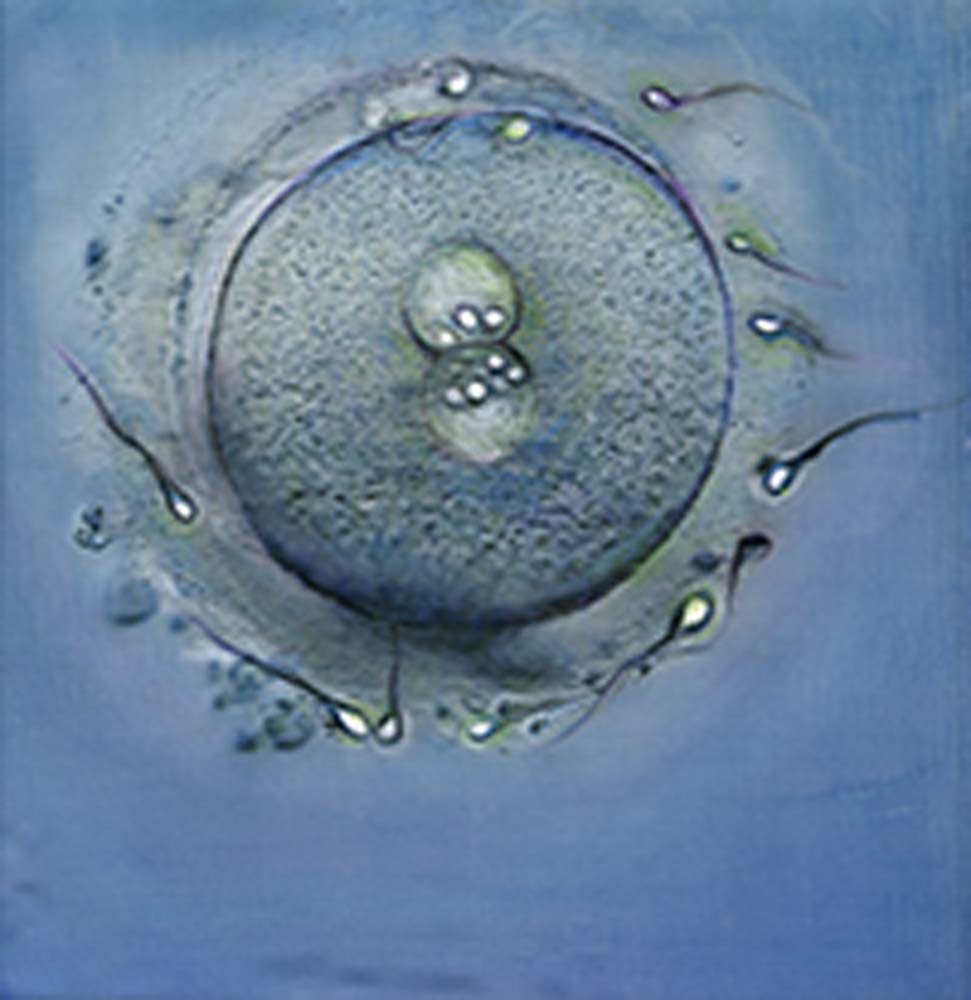Becoming You
IN VITRO FERTILIZATION FILM STILLS
Fertilization, Cleavage, 2 Cell Stage, 4 Cell Stage, 8 Cell Stage,16 Cell Stage, 32 Cell Stage, Blastocyst
Digital photo, hand painted on silk.
12” x 12”
The in vitro fertilization film was made at the Fertility Clinic at The University of Tokyo, Department of Obstetrics and Gynecology. Each still image captures the most significant stages in early egg development. They are observed after in vitro fertilization to see that all stages have formed properly and to see that the egg will be viable to implant. These images are featured in the book Becoming You, to show early development, genetic testing, and full gestation.
BECOMING YOU
The Aim of the Book. Genetic Testing has infiltrated society in ways that has changed our view on genetics. Now we relate genetics more to disease and to forensic medicine. Although this has been very helpful, it has emphasized the deterministic value of genetics, lending a negative image to genetics. The first author is a working genetic counselor/reproductive endocrinologist, and has seen numerous prospectively pregnant patients and pregnant patients trying to make a decision based on false assumptions about genetics. Worldwide, increasing numbers of people are deciding to undergo testing, many unaware of what they are being tested for or really misunderstanding the results of these tests.
After receiving counseling and information, these patients are able to make a better decision for themselves.
With genetic testing becoming more and more extensive and gene editing on the horizon, the first author has felt strongly that children need to be more educated on genetics in order to view genetics in a more positive and beautiful way so that they can make a more autonomous choice when the time comes to do so themselves.
So, the aim of this book is to give an understanding of how the reader, as a child, came to be him or herself in relation to their own genetics. It is based on the latest scientific research being conducted throughout the world, including epigenetics, where scientists are trying to enhance our understanding of developmental biology with respect to genetics. Many of the previous children’s books have been either focused on DNA or genes, with comic-like illustrations. While these books are informative, they often emphasize the deterministic qualities in genetics, often concluding in genetics being able to find criminals and pin unfavorable conditions [this sentence needs to be more clear]. In our book, we use images personally obtained from fertility clinics the first author (ST) works for, as well as from university-affiliated laboratories like Yale University, the University of Tokyo, and Kings College London. We printed these images on silk, painted on them using watercolor, and drew on them with colored pencils to deveelop a translucent and 4-dimensional look so children can appreciate the beauty of developmental biology and genetics. In the attached demo book, the images are scanned, but we would like to photograph them for our final book for better quality. Instead of the comical illustrations, we have a pop-up by printing on tracing paper for some of the pages and making a book-inside-a-book to create a “your recipe” page. If the expense allows, we would like to use a pop-up 3-D double helix for our DNA image. There is a workbook at the end which we hope will encourage children to think for themselves.
The Scope of the Book: The book begins from the reader at the point of conception and ends at their respective age. While it includes terminology such as sperm and egg, we have eliminated sexual intercourse, since it would distract the reader from the focus on a developing embryo, and because the image used is from in vitro fertilization (IVF)and not a product of sexual intercourse. We have incorporated embryo testing and prenatal testing into the book using a neutral voice (rather than being judgmental) so that children know that such tests exist. The intended audience for the book is 1) children range from middle school age and 2) adults (especially for those who have undergone fertility treatment), with basic knowledge of human fertilization involving egg and sperm.
Author(s) and Affiliation(s):
Shizuko Takahashi M.D., Ph.D
The University of Tokyo, Graduate School of Medicine
Department of Biomedical Ethics
Department of Obstetrics and Gynecology
Geraldine Ondrizek
Professor of Art
Reed College
http://www.reed.edu/art/faculty/ondrizek
Shizuko Takahashi M.D. Ph.D received BA from Reed College in Molecular Biology and Fine Arts in 1997. She did her thesis on Molecular Biology with Peter J. Russell and her Studio Art Thesis with Geraldine Ondrizek. She then attended medical school at Tokai University, School of Medicine (Isehara, Japan), and obtained her MD in 2002. After residency at the Japanese Red Cross Hospital and the University of Tokyo Hospital, Department of Obstetrics and Gynecology, she studied at the University of Tokyo, Graduate School of Medicine in both the Department of Obstetrics and Gynecology, and the Center for Biomedical Ethics and Law. She received her PhD in 2010 and her dissertation was on the decision-making process of fate of frozen embryos for infertile women in Japan, focusing on the cultural implications on how embryos are perceived. In addition, after the great eastern earthquake in 2011 in Japan, she has been involved in disaster medical ethics. Her works have been published in BMC Medical Ethics, Lancet, and BMJ, and she has given lectures at the University of Tokyo.
Her past work: The decision-making process for the fate of frozen embryos by Japanese infertile women: a qualitative study Shizuko Takahashi,1,2 Misao Fujita, #2 Akihisa Fujimoto, #1 Toshihiro Fujiwara, #3 Tetsu Yano, #1 Osamu Tsutsumi, #3 Yuji Taketani, #1 and Akira Akabayashi #2










